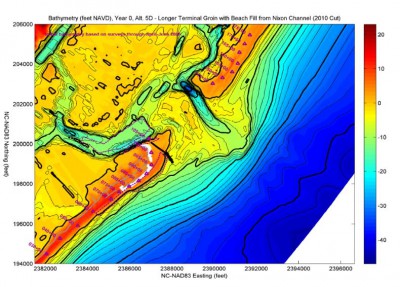WILMINGTON — An update to a 2012 federal study of a proposed terminal groin at Figure Eight Island details a new preferred design that includes a structure that is longer, bigger and about 420 feet farther north of the alternatives listed in the original study.
The Army Corps of Engineers has released its supplemental draft Environmental Impact Statement, or EIS, of the newest terminal groin design and location preferred by the island’s homeowners association’s board of directors.
Supporter Spotlight

Pressed by environmental groups, the Corps decided to amend its draft EIS more than a year after the Figure Eight Island Homeowners Association’s board agreed on a revised project alternative well after the public comment period ended for the draft study.
The amended study’s release starts a 45-day public comment that ends Aug. 24.
The Corps does not plan to hold a public hearing on the updated study, said Mickey Sugg, project manager with the Corps’ Wilmington office. “At this time we don’t feel that it’s necessary,” he said.
That may change if the Corps receives requests for a public hearing on the supplemental EIS, Sugg said.
Skipping a public hearing would be a disservice to the public, opponents of the proposed terminal groin argue.
Supporter Spotlight
A major concern of project critics is that the Corps’ has yet to formally start the required consultation with the U.S. Fish and Wildlife Service about threatened and endangered species that use Rich Inlet as critical habitat.
“That should happen as early in the draft process as possible,” said Mike Giles, a coastal advocate with the N.C. Coastal Federation. “How can they issue the draft EIS almost two years ago without this formal consultation? They don’t have the full picture.”
The federation and Audubon North Carolina last year sent a letter to the Corps through the Southern Environmental Law Center asking the agency to initiate consultation.

“They’ve had plenty of time to start the consultation process,” said Geoff Gisler, a senior attorney with the SELC. “The failure to include any discussion of consultation prior to this supplement is really hard to explain, particularly when an EIS is to provide the public information.”
Sugg defended the Corps’ decision to wait. “If we initiated consultation prior to the draft EIS then in all likelihood we would have to amend the biological assessment again,” he said. “We have been informally consulting with Fish and Wildlife. We have been doing that since the beginning. Fish and Wildlife has been notified of the changes and they’ve been part of the project from the very beginning.”
Since 2006, sand has accreted at the north end, creating what is now nearly 60 acres of unspoiled beach. The accretion of sand on the north defeats a need for a terminal groin, opponents say.
“The reality of Figure Eight right now is there is a lot more beach than there used to be,” Gisler said. “The Corps can’t dismiss the reality of what’s on the ground.”
The spit at the north end where the 1,500-foot rock groin would be built is critical habitat to thousands of shorebirds, including piping plover and red knots, which are protected under federal law.
If a terminal groin is built on the north end, at least some portion of the spit would wash away. That habitat loss will likely affect foraging and roosting behavior of shorebirds, according to the supplemental study.

“Birds use habitats throughout the inlet,” said Lindsay Addison, a biologist with Audubon North Carolina. “They use the entire inlet. They use the backside, the inner tidal portion of that spit. The loss of that spit, which is what the terminal groin would seem to produce, represents significant loss for piping plovers, red knots and all other shorebirds that use Rich Inlet.”
The bar channel in Rich Inlet historically shifts to a more northern alignment toward Hutaff Island, a move that is expected to occur in the future and prompt erosion at the north end, according to the study.
“The conditions are favorable right now for an unknown period of time, but we know that will change and the erosion will return,” said David Kellam, the Figure Eight Island administrator.
Kellam said the homeowners association’s board has not started the process of obtaining rights-of-way needed to build a terminal groin across properties at the north end.
The board will have to get rights-of-way from anywhere from eight to 12 properties, he said. “It all depends upon where we built it,” Kellam said.
Since the island is not incorporated, the board cannot take the necessary land through eminent domain.
Kellam said the board would like to be in a position to build a terminal groin once it has received all of the state and federal permits required for construction.
The cost to build the terminal groin, based on very preliminary estimates, is between $2.5 million and $4 million, he said.
Related Content
Groin Project Threatens Tern Habitat
Terminal Groin Will Get Another Look
What Will a Groin Do to the Rare Birds of Rich Inlet?
Learn More
Supplemental EIS: http://www.saw.usace.army.mil/Missions/RegulatoryPermitProgram/MajorProjects/SEISFigure8.aspx







